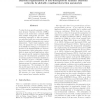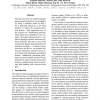138
click to vote
JMLR
2012
13 years 3 months ago
2012
To relax the homogeneity assumption of classical dynamic Bayesian networks (DBNs), various recent studies have combined DBNs with multiple changepoint processes. The underlying as...
144
click to vote
PR
2011
14 years 4 months ago
2011
This paper aims to address the problem of anomaly detection and discrimination in complex behaviours, where anomalies are subtle and difficult to detect owing to the complex tempo...
97
Voted
ICASSP
2011
IEEE
14 years 4 months ago
2011
IEEE
We address the problem of pronunciation variation in conversational speech with a context-dependent articulatory featurebased model. The model is an extension of previous work usi...
131
Voted
JMLR
2010
14 years 8 months ago
2010
Learning dynamic Bayesian network structures provides a principled mechanism for identifying conditional dependencies in time-series data. An important assumption of traditional D...
113
Voted
EXPERT
2010
14 years 10 months ago
2010
Human behavior recognition is one of the most important and challenging objectives performed by intelligent vision systems. Several issues must be faced in this domain ranging fro...
125
Voted
KI
2010
Springer
14 years 11 months ago
2010
Springer
Recognizing human intentions is part of the decision process in many technical devices. In order to achieve natural interaction, the required estimation quality and the used comput...
102
Voted
ACL
2010
14 years 11 months ago
2010
Most previous work on trainable language generation has focused on two paradigms: (a) using a statistical model to rank a set of generated utterances, or (b) using statistics to i...
112
click to vote
ICML
2010
IEEE
14 years 11 months ago
2010
IEEE
Classical dynamic Bayesian networks (DBNs) are based on the homogeneous Markov assumption and cannot deal with heterogeneity and non-stationarity in temporal processes. Various ap...
109
Voted
IJAR
2002
15 years 26 days ago
2002
The usual methods of applying Bayesian networks to the modeling of temporal processes, such as Dean and Kanazawa's dynamic Bayesian networks (DBNs), consist in discretizing t...
115
Voted
JMM2
2007
15 years 1 months ago
2007
Abstract— Activity recognition in video streams is increasingly important for both the computer vision and artificial intelligence communities. Activity recognition has many app...





